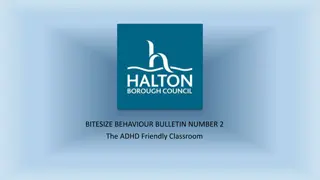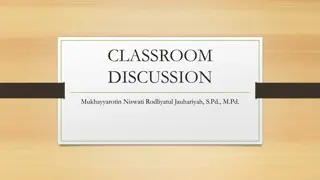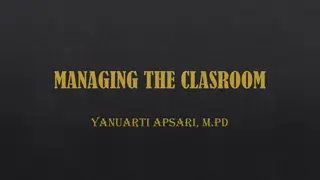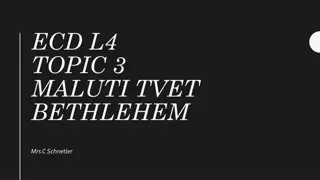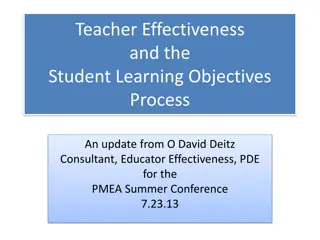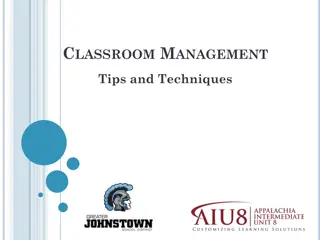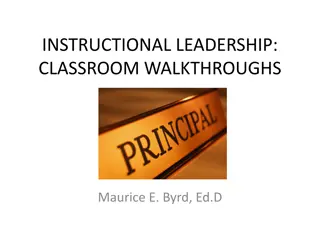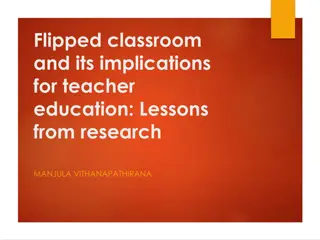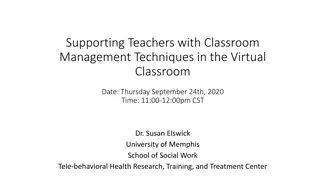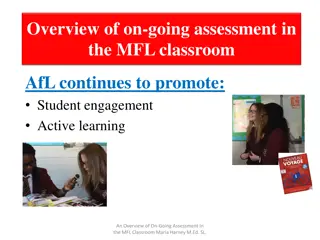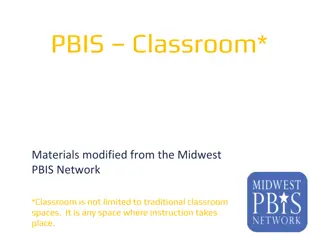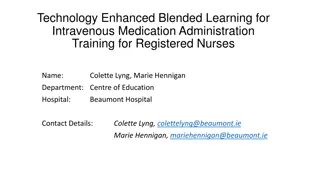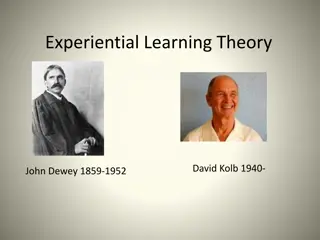Transforming Your Classroom Environment for Enhanced Learning Experience
Enhance your classroom environment by incorporating elements of authenticity and genuine interactions. Discover the importance of being yourself as a teacher and learn practical steps to foster a welcoming and engaging space for both you and your students.
Download Presentation

Please find below an Image/Link to download the presentation.
The content on the website is provided AS IS for your information and personal use only. It may not be sold, licensed, or shared on other websites without obtaining consent from the author. Download presentation by click this link. If you encounter any issues during the download, it is possible that the publisher has removed the file from their server.
E N D
Presentation Transcript
Improving the classroom environment How to improve classroom environment? My classroom is so unwelcoming and dull! Even I feel my spirits sinking when I walk in. Goodness knows how the learners feel. Page 23-25 should be read
Being yourself What does Authenticity mean?
Authenticity means behaving in a way that is appropriately real, appropriately you - letting the students see something of your genuine/real reactions to things, your moods and your natural behaviour, rather than covering everything up in a performance.
Carl Rogers, the US educational psychologist He believed that authenticity created the conditions for good rapport and helped build a real depth/deepness of trust and respect, and that this made the difference between a successful classroom and an unsuccessful one.
* Five steps to authenticity 1. Don't try to be a 'teacher 2. Have real conversations 3. Don't pretend omniscience 4. Be wary of staffroom advice 5. Be appropriately authoritative
1. Don't try to be a 'teacher' Stop yourself whenever you find yourself behaving more as a job title rather than as yourself. Don't speak as if you are some sort of official mouthpiece for the teaching profession or your school. Don't seek out additional ways of differentiating yourself as a teacher.
2 Have real conversations When you chat informally with a student, make it a reaI conversation, where you really listen to what they have to say and respond appropriately. Give your own genuine personal reactions to student comments. If something a student says makes you disagree, say so, instead of 'Hmrnm, interesting'.
3. Don't pretend omniscience If you don't know an answer to a question, say that, rather than pretending that you do know or confusing students with roundabout explanations and avoidances.
4. Be wary of staffroom advice Colleagues may tell you that being genuinely warm and friendly with students is dangerous, or that it is essential for a teacher to keep up a front- as someone reserved, formal and a little distant. Their comments are probably well-intentioned, but treat such advice cautiously, and make sure you think it through for yourself before you decide to follow it.
5. Be appropriately authoritative Being authentic doesn't mean abdicating/abandon the responsibilities and duties of a teacher. You can still give all the instructions, set all the homework and all the things that you need to do. You can be appropriately authoritative. The difference is that it is you being authoritative, not you using the cloak/mask of teacher superiority and hierarchical authority to do it.
Establishing and maintaining rapport
What does rapport mean? The term rapport refers to the quality of the relationship in a classroom: teacher-student and student-student.
* There are 8 technics to built a good rapport 1. Be welcoming, be encouraging, be approachable 2. Treat each learner as an individual 3. Remember positive things about your students 4. Empathise 5. Be you rather than 'the teacher 6. Don't fake happiness or pleasure 7. Be culturally sensitive 8. Avoid sarcasm
Is it ok to be a friends with students? Some teachers would shout 'no very loudly to that question. Some would answer that they can't imagine teaching without friendship. Others would advise keeping a balance between getting to know your students and maintaining a certain teacher distance. Your own response may partly depend on a number of variables including the context where you teach, the age of your students and the amount of time you have together.
Students are workers Who they are outside the class is irrelevant to in-classroom work. Interaction in class should be entirely work- focussed. The teacher should not ask questions about personal issues. Friendship is irrelevant, unnecessary and potentially dangerous. Students are students Who they are outside the class is sometimes relevant to in-classroom work. Interaction in class should be mainly work- focussed, though there is space for other things. The teacher can ask questions about personal issues, if necessary. A respectful working relationship is more important that friendship. Students are people Who they are outside the class is crucial to in- classroom work. Interaction in class should be normal human interaction, person to person. The teacher should take an active interest in the students as whole people. Friendship is natural between people who respect each other and work together.
Turning the volume up and down I find that I sometimes get locked into talking at 'public-announcement' volume level for everything I do in class and wonder if I can vary this at al.
Are you loud or quite teacher? What do you think, what kind of teachers are effective.?
You might expect that speaking loudly would command the most attention from students whereas speaking quietly would lead to a drop of interest and engagement. Many teachers, when they experiment a little, discover that, in fact, the opposite can sometimes be the case.
When someone speaks loudly, one fairly natural human reaction seems to be to completely tune it out and avoid it
When we hear someone talking quietly, we are often curious and want to tune in and listen more carefully.
To do this, we probably need to stop doing whatever we are doing and especially stop making any distracting or interfering noise ourselves.
Students tend to mirror the teacher's volume. If you have a noisy class, speak quieter rather than louder - and they might too.
1 Experiment with using different volumes in class. For different tasks, try varying the volume; for example, using a much quieter than usual voice for one set of instructions, then using a much louder than usual voice for running a game.
Do students seem to be more active in louder or quieter stages? Does the volume have any effect on their own use of language? Does it provide any sense of extra variety in the lesson?
Start a lesson very quietly. Rather than kicking off with a big announcement or instruction, simply start talking at a reduced volume. Initially, students may not even notice that you have started. Keep going without raising the volume. Does the class slowly calm down and start tuning in?
When you want to start a new task, try giving the instruction extremely quietly. You can repeat it a few times if need be, but don't increase the volume. Do the students listen with as much attention as normal? (Or more? Or less?)
Tell an interesting or amusing story or personal anecdote - but do it in an unusually quiet or low voice.
Ok everybody! Your homework is your workbook. As you did page number 59-65 page 66 to 71 has to be done by tomorrow early in the morning. On the next lesson I mean tomorrow s third hour. I will check your homework. it is going to be evaluated over 15 %. If you forget to do or lost notebooks, you will bear the consequence.
Finding the right voice tone Your voice tone and how you use it can help create a large part of the atmosphere of your classroom - yet many teachers have never consciously thought much about it or worked on improving their skills.
Humpty Dumpty sat on the wall. Humpty Dumpty had a great fall. All the king's horses and all the king's men couldn't put Humpty together again. excited, bored, angry, in charge, uncertain, disappointed, overjoyed, impatient.
Ok everybody! Your homework is your workbook. As you did page number 59-65 page 66 to 71 has to be done by tomorrow early in the morning. On the next lesson I mean tomorrow s third hour. I will check your homework. it is going to be evaluated over 15 %. If you forget to do or lost notebooks, you will bear the consequence.
Experimenting with voice tone in class An open, warm, friendly tone: for chatting and asking personal questions. A factual, information-giving tone: for instructions or short pieces of information. A storytelling tone: for a narrative or read-aloud text.
A personal, supportive, kindly tone: for helping one-to-one when a student has a problem. An authoritative tone: for telling someone what they must do, and leaving no space for discussion. A humorous tone: for a joke, anecdote or a comment that will make people laugh. A hesitant uncertain tone: perhaps when asking for students to correct the teacher's errors, for checking or eliciting.



